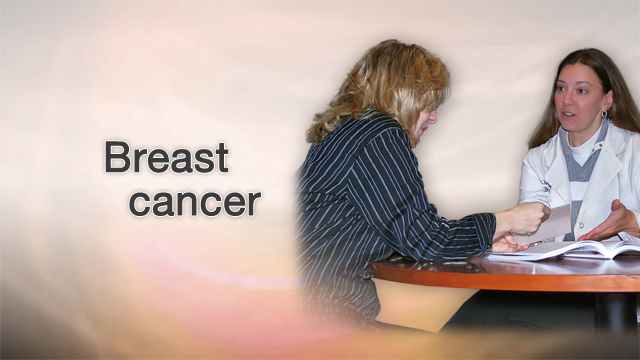Breast biopsy - ultrasound
Biopsy - breast - ultrasound; Ultrasound-guided breast biopsy; Core needle breast biopsy - ultrasound; Breast cancer - breast biopsy - ultrasound; Abnormal mammogram - breast biopsy - ultrasound
A breast biopsy is the removal of breast tissue to examine it for signs of breast cancer or other disorders.
There are several types of breast biopsies, including stereotactic, ultrasound-guided, MRI-guided, and excisional breast biopsy. This article focuses on needle-based, ultrasound-guided breast biopsies. This procedure is usually done by a radiologist or surgeon.

How the Test is Performed
You are asked to undress from the waist up. You wear a robe that opens in the front. During the biopsy, you are awake.
You lie on your back.
The biopsy is done in the following way:
- The doctor cleans the area on your breast.
- Numbing medicine is injected.
- The doctor makes a very small cut on your breast over the area that needs to be biopsied.
- The doctor uses an ultrasound machine to guide the needle to the abnormal area in your breast that needs to be biopsied.
- Several small pieces of tissue are taken.
- A small metal clip may be placed into the breast in the area of the biopsy to mark it, if needed.
The biopsy is done using one of the following:
- Fine needle aspiration
- Hollow needle (called a core needle)
- Vacuum-powered device
- Both a hollow needle and vacuum-powered device
Once the tissue sample has been taken, the needle is removed. Ice and pressure are applied to the site to stop any bleeding. A bandage is applied to absorb any fluid. You do not need any stitches after the needle is taken out. If needed, strips of tape may be placed to close the wound.
How to Prepare for the Test
The health care provider will ask about your medical history and may perform a manual breast exam.
If you take blood thinning medicines (including aspirin, supplements, or herbs), ask your doctor whether you need to stop taking these before the biopsy.
Tell your doctor if you may be pregnant.
Do not use lotion, perfume, powder, or deodorant underneath your arms or on your breasts.
How the Test will Feel
When the numbing medicine is injected, it may sting a bit.
During the procedure, you may feel slight discomfort or light pressure.
After the test, the breast may be sore and tender to the touch for several days. You will be given instructions about what activities you can do, how to take care of your breast, and what medicines you can take for pain.
You may have some bruising, and there will be a very small scar where the needle was inserted.
Why the Test is Performed
An ultrasound-guided breast biopsy may be done to evaluate abnormal findings on a mammogram, breast ultrasound, or MRI.
To determine whether someone has breast cancer, a biopsy must be done. Tissue from the abnormal area is removed and examined under a microscope.
Normal Results
A normal result means there is no sign of cancer or other breast problems.
Your provider will let you know if and when you need a follow-up ultrasound, mammogram or other tests.
What Abnormal Results Mean
A biopsy can identify a number of breast conditions that are not cancer or precancer, including:
- Fibroadenoma (breast lump that usually isn't cancer)
- Fat necrosis
Biopsy results may show abnormal conditions such as:
- Atypical ductal hyperplasia
- Atypical lobular hyperplasia
- Flat epithelial atypia
- Intraductal papilloma
- Lobular carcinoma-in-situ
- Radial scar
- Fibroepithelial lesion
- Mucocele-like lesion
If the biopsy result is benign, you may not need any further treatment, though sometimes surgery to remove a benign condition is recommended. If the biopsy shows an abnormal condition, you may be referred to a surgeon to discuss a surgical biopsy to remove the entire area and test it more thoroughly.
Depending on surgical biopsy results, you may need further surgery or treatment.
Your provider will discuss the meaning of the biopsy results with you.
Risks
There is a slight chance of infection at the injection or incision site. Excessive bleeding is rare.
References
American College of Radiology website. ACR practice parameter for the performance of ultrasound-guided percutaneous breast interventional procedures. www.acr.org/-/media/ACR/Files/Practice-Parameters/us-guidedbreast.pdf. Updated 2021. Accessed April 5, 2023.
Henry NL, Shah PD, Haider I, Freer PE, Jagsi R, Sabel MS. Cancer of the breast. In: Niederhuber JE, Armitage JO, Kastan MB, Doroshow JH, Tepper JE, eds. Abeloff's Clinical Oncology. 6th ed. Philadelphia, PA: Elsevier; 2020:chap 88.
Thigpen DM, Huppe AI, Mehta AK, Brem RF. Breast biopsy and ablation. In: Mauro MA, Murphy KPJ, Thomson KR, Venbrux AC, Morgan RA, eds. Image-Guided Interventions. 3rd ed. Philadelphia, PA: Elsevier; 2021:chap 105.
Review Date: 3/11/2023


